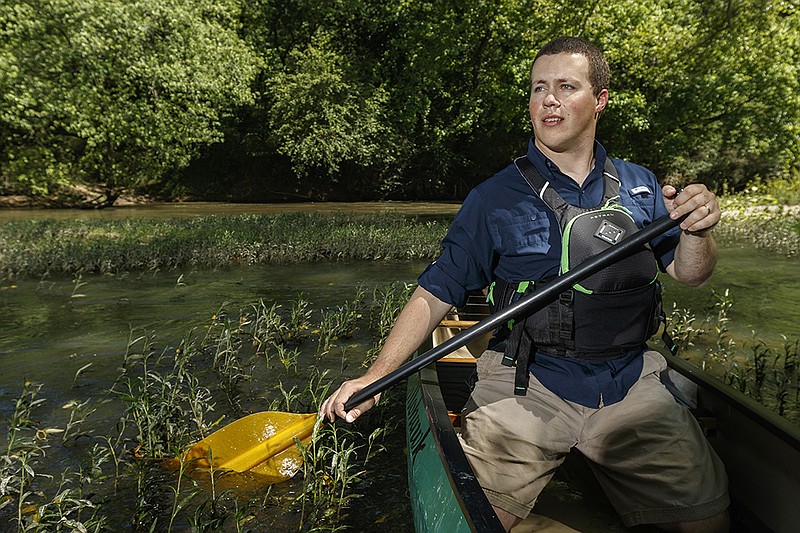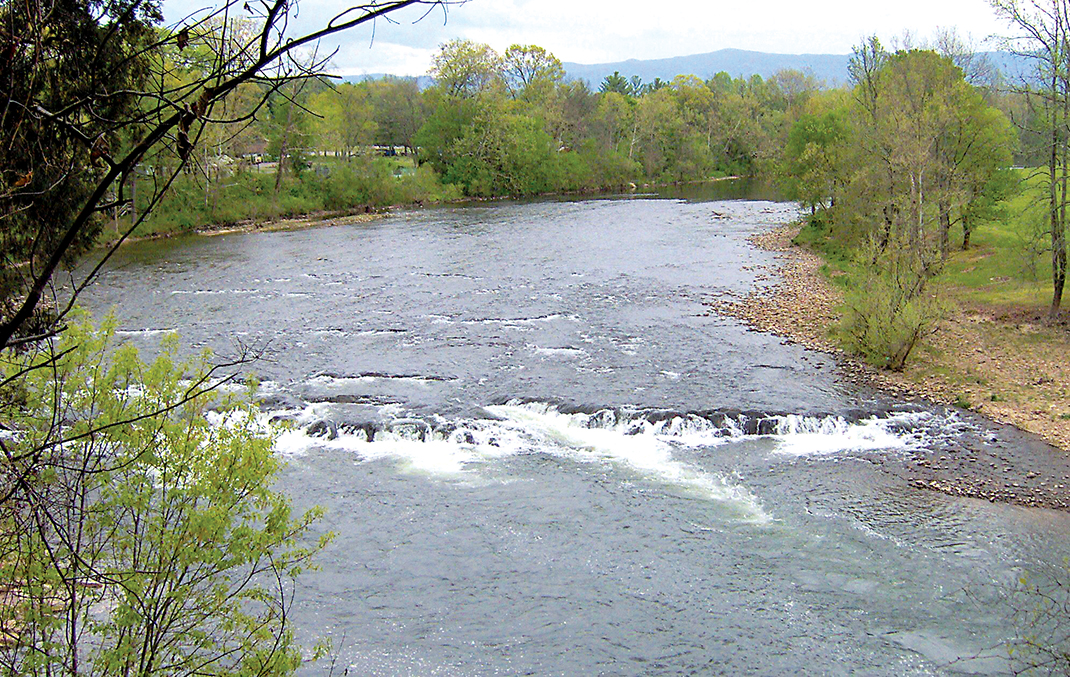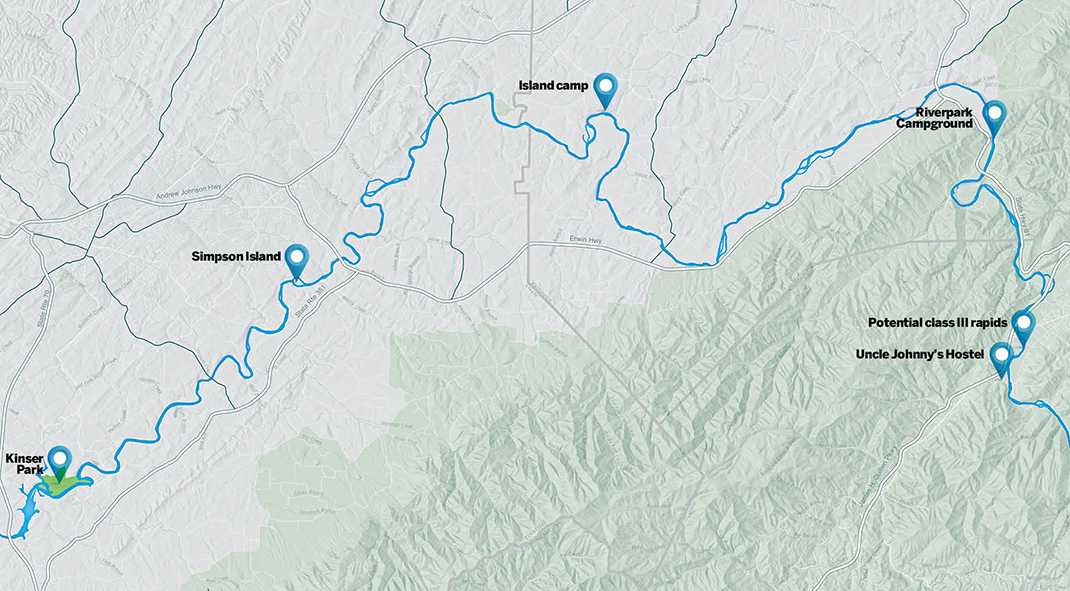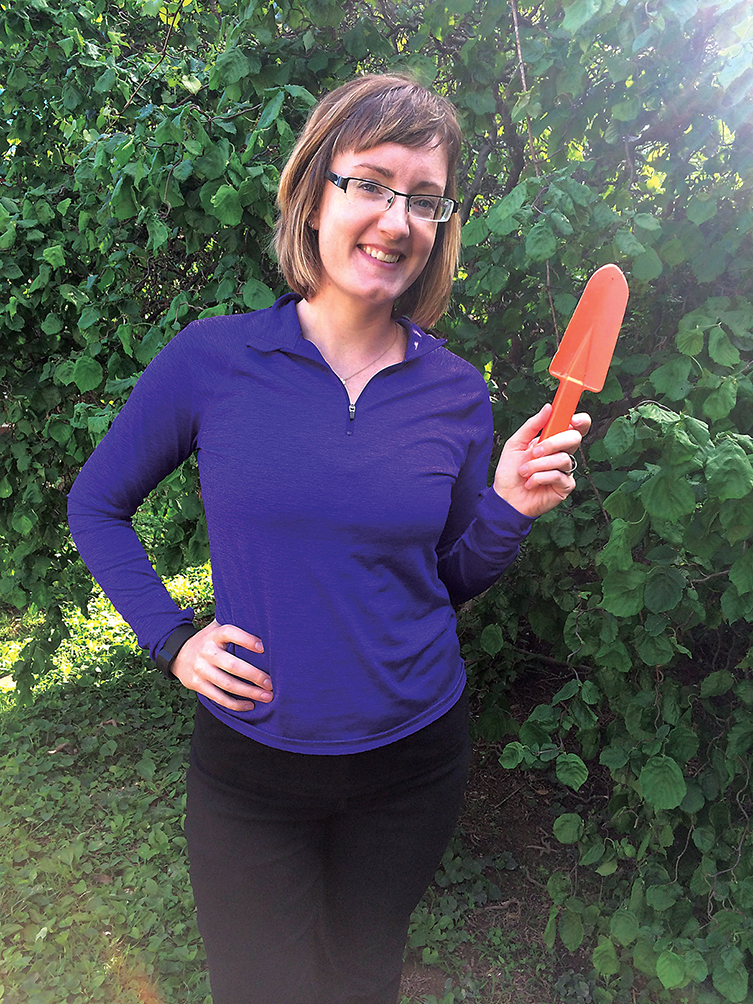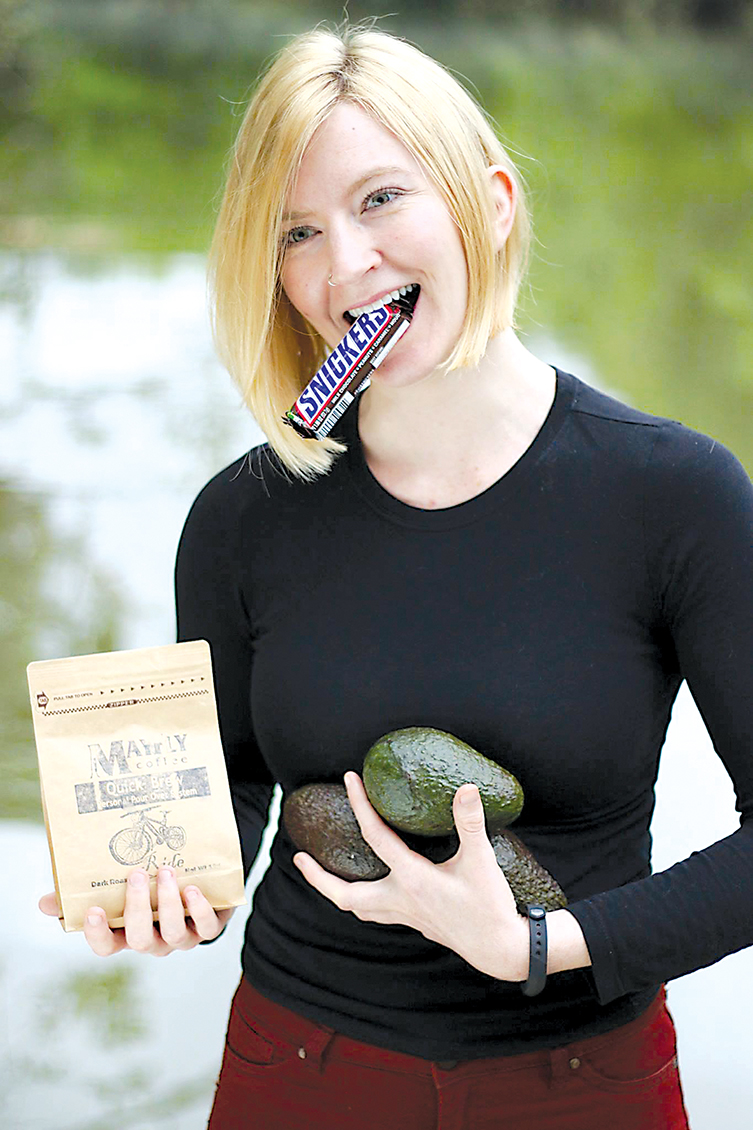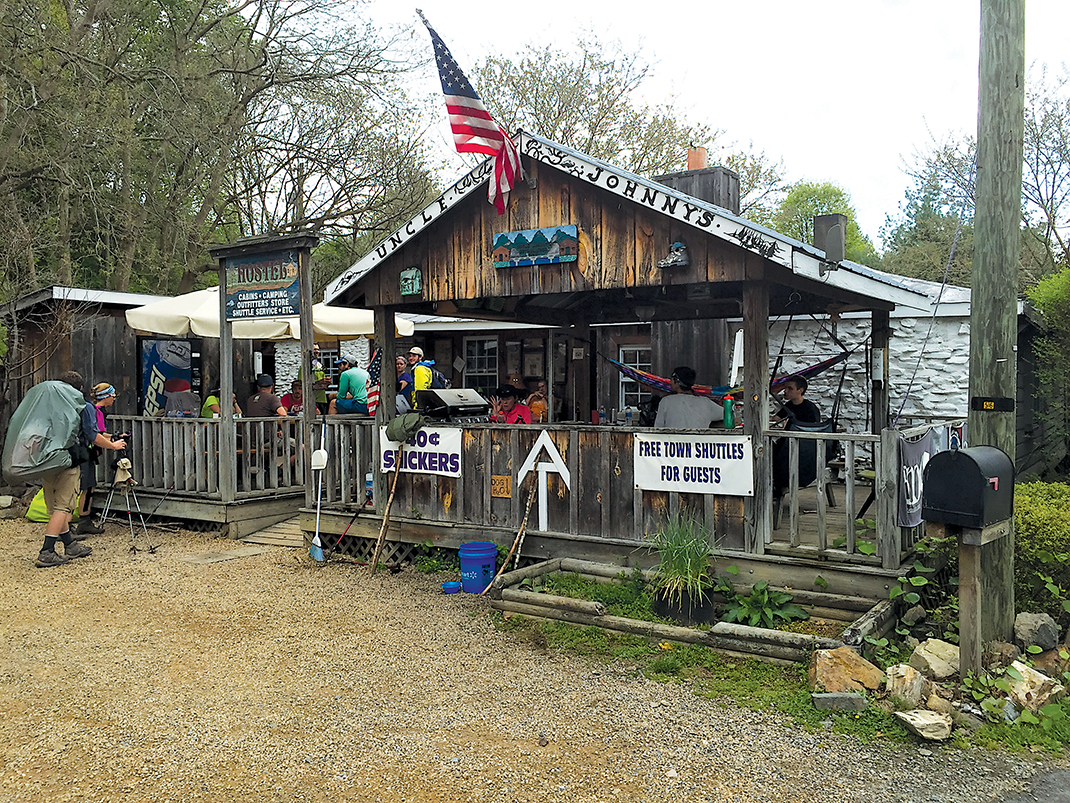In two weeks, two friends and I will embark on a four-day, 51-mile paddling trip down the Nolichucky River.
The Nolichucky is a scenic waterway that flows through east Tennessee and western North Carolina. The upper section is famous for its whitewater. But Kyle Simpson, Teresa Lee and I plan to paddle the tamer lower-middle section, boating from Uncle Johnny's Hostel & Outfitter in Erwin, Tennessee, to Kinser Park in Greeneville, Tennessee.To date, my longest paddle has been a 12-mile day trip on the South Chickamauga Creek. In fact, between the three of us, Kyle is the only one who has been on overnight paddling trips. So Teresa and I were grateful to have him take the helm on planning, and even more so to discover his penchant for list-making. Three months before our departure, Kyle had drafted our itinerary, pack-lists and even proposed meal schedules.
To help you plan a long-distance paddling trip of your own (or to follow in the wake of ours), here I share with you Kyle's well-laid plans.
His first piece of advice? "Start with the basics and go from there."
Most basic of all, of course, is your destination. So, how do you choose the right blueway for your trip?
The Itinerary:
Day 1: 9 milesPut in at Uncle Johnny’s Hostel & Outfitter.Take out/camp at Riverpark Campground.Day 2: 15 milesTake out at island.Day 3: 14 milesTake out/camp at Simpson Island.Day 4: 13 milesTake out at Kinser Park.
First, get to know your options. Kyle suggests virtually exploring waterways via Google Maps. The satellite view can capture geographical details as fine as whitewater, boat launches, campgrounds and, most importantly, dams - which should be avoided, though that can be difficult.
"Long stretches of undammed rivers are hard to find, especially in the Southeast," Kyle says. "The Tennessee River is beautiful, but imagine having to portage around the Chickamauga Dam with 200 pounds of gear."
Another online resource Kyle recommends is americanwhitewater.org, a website that lets you search rivers by name, state or class of rapid and then read descriptions and reviews of its various stretches.
Kyle says he chose the Nolichucky for two reasons. First, because it boasts a long, unimpeded stretch. Second, because it features some whitewater. While our section is mostly flat water, it does include several class II rapids and one class III rapid.
Admittedly, the idea of a class III rapid made me nervous, especially after seeing "whitewater helmet" on our pack-list. But what is an adventure without a challenge? An overnighter on the river is about immersing oneself in the wild and moving outside of one's comfort zone.
However, mixed-water does pose the question: What is the best boat to bring?
Kyle's Mohawk XL-15 tandem whitewater canoe
Ample cargo capacity Wider (33 inches side-to-side), providing more stability More rocker, meaning more control in whitewater Conversely, more rocker makes the boat less efficient during long stretches of flat water.
Teresa's Liquid Logic Remix XP10
Good storage space At just 10-feet-long, the boat is more maneuverable in rough water. However, its length will make it more of a challenge for the boat to keep up on flat water.
Sunny's sit-on-top Ocean Kayak Trident 13
No risk of becoming trapped if boat flips SoT's are self-bailing should the boat take on water. Length makes it more efficient on flat water Not being connected to the boat gives the paddler less body-control in steering.
The Boat:
Choosing the right watercraft, Kyle says, is about balancing maneuverability with efficiency.
Maneuverability refers to how a boat handles rapids. A shorter boat with more rocker, or more curve to its bottom, does better in whitewater. Meanwhile, efficiency refers to how easily a boat propels forward, in which case, a longer, skinnier boat does better.
Of course, the right boat is also one in which the paddler feels comfortable and, of course, has plenty of cargo capacity. Kyle, Teresa and I will all be in different boats, each with its own advantages and disadvantages.
The Pack List:
The next component of planning an extended paddle is to determine - or confront, in some cases - necessary items to bring. If "whitewater helmet" forced me to look beyond my boundaries, "poop shovel" certainly did the same. Indeed, not all gear is glamorous, but, nonetheless, it is important. According to Leave No Trace ethics, human waste should be buried in a 6-inch "cathole" located at least 80 steps away from campsites, water sources or shelters.
Still, I was mostly delighted by Kyle's pack-list, which gave me the excuse to invest in several fun, new outdoor toys. For example, a water purifier and a solar phone charger.
Here is a full list of what we each will bring.
Boat supplies:
» Personal flotation device
» Dry bags, at least three 20L bags
» Spray skirt (if required) Teresa's kayak is the only boat in our fleet requiring a spray skirt. Should you opt for a kayak requiring a spray skirt, it is wise to take a few whitewater classes. If your boat flips, you will need some technical skill to roll it or at least to perform a successful wet exit.
» Paddling gloves
» Paddle (one extra paddle per group is a good idea)
» Whitewater helmet
Personal supplies:» Rain gear
» Water bottle
» River shoes
» Camp shoes
» Sunscreen
» Sunglasses
» Sunglasses strap
» Hat
» Sunscreen
» First aid kit (one per group will suffice, but extra Band-Aids or rubbing alcohol won't hurt)
» Toilet paper
» Hand sanitizer
» Cable and lock for boat
» Poop shovel (one per group - unless that weirds you out, then bring your own)
» Washcloth If you wish to shower, the river will likely be your only option. Do the fish a favor and avoid soaps - even biodegradable soaps can be harmful to aquatic life. The most eco-friendly option is water, a washcloth and a good scrubbing.
Camp supplies:
» Tent Tree tent or pole tent? An advantage of the tree tent is its compact size. A disadvantage is that, because it is suspended off the ground, it can be colder at night. Teresa and I will be sharing a two-person pole tent. Kyle has a tree tent - and a pro tip for using it: Position your body diagonally to avoid having your spine curved by the tent's sagged bottom.
» Flashlight
» Sleeping bag
» Water purifier (two purifiers per group are best, in case one breaks)
» Cookware/silverware
» Knife
» Solar charger
» Stove (one per group)
» Propane (one per group)
» Lighter
» Garbage bags
» Camp chair
» Camp pillow
» Tarp
» Bilge pump or bailing bucket
» Thermacell (optional/one per group) This is a butane-powered mosquito repellent that uses heat to disperse repellent, creating a 15-by-15-foot protected area. It works great for the campsite, but not for the boat, Kyle says, as it must be stationary to work well.
» Duct tape
» Camp saw
» Cooler (optional) Once you pack a cooler with food, drinks and ice, it is easily the heaviest thing you'll tow, Kyle says. Weight will slow you down, but if a cold drink or a piece of meat for the campfire is worth it to you, by all means!
Sustenance:There is no right or wrong grocery list. However, Kyle says, "Any time you can avoid dirtying dishes, that's a plus."
Foil-wrap dinners are a great option. They are made by wrapping any number of ingredients in aluminum foil to cook over the campfire. Steak, peppers, mushrooms, asparagus or sliced potatoes are just some examples. Freeze-dried meals work well, too, prepared by pouring water directly into the bag. In addition to snacks like beef jerky, trail mix, cereal and fruit, we also each have our own must-have list.
Sunny's must-haves:
» Mayfly Quick-Brew campfire coffee
» Avocados
» Snickers bar
Kyle's must-haves:
» Dr. Pepper
» Reese's Pieces trail mix
Teresa's must-haves:
» West Sixth Brewing India Pale Ale, one for each night
Hostels and Campsites:
The first night of our trip, we will sleep at Uncle Johnny's Hostel & Outfitters, where we will share a room for a total of $25. The next night, we'll camp at Riverpark Campground. Then, the last two nights, we'll primitive camp on two different islands.
Again, Kyle recommends making Google Maps your friend. He found all of our sleeping spots simply by scrolling along the Nolichucky riverbanks. Once you find a place of interest on the map - whether it be a campground, shuttle service or patch of whitewater - Google Maps lets you "drop a pin," thus saving the location and its GPS coordinates to "your places."
Shuttle Services:
It is necessary to call your shuttle service to find out about its policies. For instance, Uncle Johnny's shuttle will haul only paddlers, not their gear nor boats.
Following our night's stay there, we plan to lock up our boats at the hostel, then make the two-hour drive to Kinser Park, where we will park our cars. That way, our vehicles will be waiting for us when we cross the finish line four days later. From Kinser Park, we arranged to be shuttled back to the hostel.
Then, we pack our boats and cast off downriver.
More Info
In 2012, the federal government created the first National Water Trails System to help connect the nation’s network of water trails. Currently, there are 21 federally designated blueways, stretching from Georgia to Washington State. Though, a national water trail is yet to be designated in Tennessee. Find out more at nps.gov/WaterTrails.
